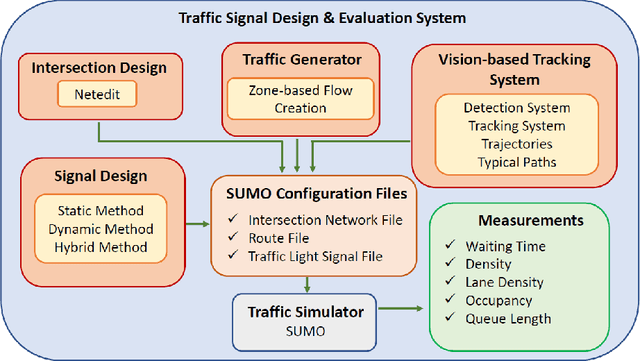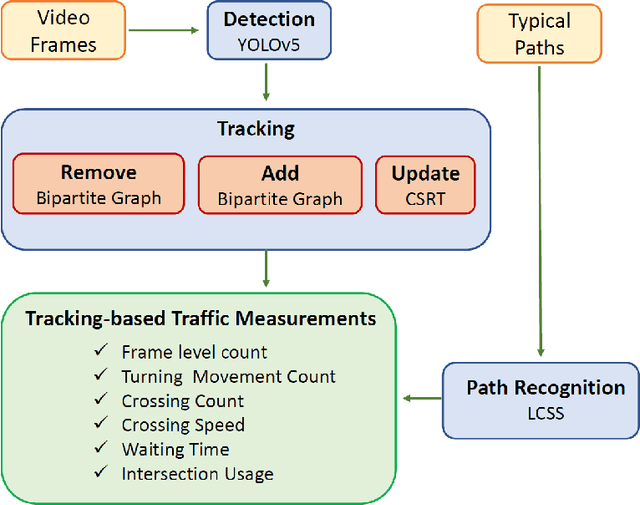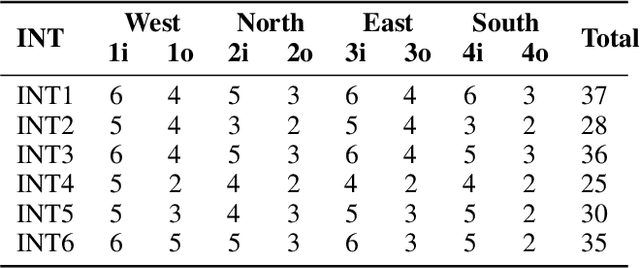Hung-Fu Chang
Evaluation of Traffic Signals for Daily Traffic Pattern
Jun 26, 2025



Abstract:The turning movement count data is crucial for traffic signal design, intersection geometry planning, traffic flow, and congestion analysis. This work proposes three methods called dynamic, static, and hybrid configuration for TMC-based traffic signals. A vision-based tracking system is developed to estimate the TMC of six intersections in Las Vegas using traffic cameras. The intersection design, route (e.g. vehicle movement directions), and signal configuration files with compatible formats are synthesized and imported into Simulation of Urban MObility for signal evaluation with realistic data. The initial experimental results based on estimated waiting times indicate that the cycle time of 90 and 120 seconds works best for all intersections. In addition, four intersections show better performance for dynamic signal timing configuration, and the other two with lower performance have a lower ratio of total vehicle count to total lanes of the intersection leg. Since daily traffic flow often exhibits a bimodal pattern, we propose a hybrid signal method that switches between dynamic and static methods, adapting to peak and off-peak traffic conditions for improved flow management. So, a built-in traffic generator module creates vehicle routes for 4 hours, including peak hours, and a signal design module produces signal schedule cycles according to static, dynamic, and hybrid methods. Vehicle count distributions are weighted differently for each zone (i.e., West, North, East, South) to generate diverse traffic patterns. The extended experimental results for 6 intersections with 4 hours of simulation time imply that zone-based traffic pattern distributions affect signal design selection. Although the static method works great for evenly zone-based traffic distribution, the hybrid method works well for highly weighted traffic at intersection pairs of the West-East and North-South zones.
A Systematic Approach for Assessing Large Language Models' Test Case Generation Capability
Feb 05, 2025



Abstract:Software testing ensures the quality and reliability of software products, but manual test case creation is labor-intensive. With the rise of large language models (LLMs), there is growing interest in unit test creation with LLMs. However, effective assessment of LLM-generated test cases is limited by the lack of standardized benchmarks that comprehensively cover diverse programming scenarios. To address the assessment of LLM's test case generation ability and lacking dataset for evaluation, we propose the Generated Benchmark from Control-Flow Structure and Variable Usage Composition (GBCV) approach, which systematically generates programs used for evaluating LLMs' test generation capabilities. By leveraging basic control-flow structures and variable usage, GBCV provides a flexible framework to create a spectrum of programs ranging from simple to complex. Because GPT-4o and GPT-3-Turbo are publicly accessible models, to present real-world regular user's use case, we use GBCV to assess LLM performance on them. Our findings indicate that GPT-4o performs better on complex program structures, while all models effectively detect boundary values in simple conditions but face challenges with arithmetic computations. This study highlights the strengths and limitations of LLMs in test generation, provides a benchmark framework, and suggests directions for future improvement.
A Framework for Collaborating a Large Language Model Tool in Brainstorming for Triggering Creative Thoughts
Oct 10, 2024Abstract:Creativity involves not only generating new ideas from scratch but also redefining existing concepts and synthesizing previous insights. Among various techniques developed to foster creative thinking, brainstorming is widely used. With recent advancements in Large Language Models (LLMs), tools like ChatGPT have significantly impacted various fields by using prompts to facilitate complex tasks. While current research primarily focuses on generating accurate responses, there is a need to explore how prompt engineering can enhance creativity, particularly in brainstorming. Therefore, this study addresses this gap by proposing a framework called GPS, which employs goals, prompts, and strategies to guide designers to systematically work with an LLM tool for improving the creativity of ideas generated during brainstorming. Additionally, we adapted the Torrance Tests of Creative Thinking (TTCT) for measuring the creativity of the ideas generated by AI. Our framework, tested through a design example and a case study, demonstrates its effectiveness in stimulating creativity and its seamless LLM tool integration into design practices. The results indicate that our framework can benefit brainstorming sessions with LLM tools, enhancing both the creativity and usefulness of generated ideas.
Leveraging Fundamental Analysis for Stock Trend Prediction for Profit
Oct 04, 2024

Abstract:This paper investigates the application of machine learning models, Long Short-Term Memory (LSTM), one-dimensional Convolutional Neural Networks (1D CNN), and Logistic Regression (LR), for predicting stock trends based on fundamental analysis. Unlike most existing studies that predominantly utilize technical or sentiment analysis, we emphasize the use of a company's financial statements and intrinsic value for trend forecasting. Using a dataset of 269 data points from publicly traded companies across various sectors from 2019 to 2023, we employ key financial ratios and the Discounted Cash Flow (DCF) model to formulate two prediction tasks: Annual Stock Price Difference (ASPD) and Difference between Current Stock Price and Intrinsic Value (DCSPIV). These tasks assess the likelihood of annual profit and current profitability, respectively. Our results demonstrate that LR models outperform CNN and LSTM models, achieving an average test accuracy of 74.66% for ASPD and 72.85% for DCSPIV. This study contributes to the limited literature on integrating fundamental analysis into machine learning for stock prediction, offering valuable insights for both academic research and practical investment strategies. By leveraging fundamental data, our approach highlights the potential for long-term stock trend prediction, supporting portfolio managers in their decision-making processes.
 Add to Chrome
Add to Chrome Add to Firefox
Add to Firefox Add to Edge
Add to Edge